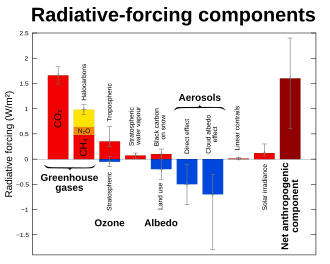User:Towerman/translation/辐射强迫

辐射强迫是指某一因子变化(比如大气中二氧化碳浓度增加)对地球-大气系统能量平衡的影响程度。任何能够扰动地气系统能量平衡并因此可能改变气候的因子都被称为辐射强迫因子。辐射强迫是研究全球气候变化的一个重要指标,定义有多种细微的变化。IPCC在其气候变化评估报告中采用的定义最为常用,即“气候变化的某个外部驱动因子的变化,如二氧化碳浓度或太阳辐射量的变化等,造成对流层顶净辐照度(向下辐射与向上辐射之差,单位用瓦每平方米表示)发生的变化”[1]。辐射强迫为正值表示地气系统吸收了更多的能量,系统将会升温;反之为负值时,系统释放更多能量,将会降温。造成辐射强迫的原因有日射的改变和辐射活跃气体(比如温室气体和气溶胶)的浓度的改变。
辐射平衡
[编辑]
绝大部分影响地球天气的能量来自于太阳的辐射能量。地球及其大气吸收和反射一部分太阳能量,同时在放射出长波辐射能量到太空中。地球的辐射平衡将决定地表的平均温度。很多因素都能够影响辐射平衡,比如太阳辐射的强度,云和气体的反射率,温室气体的吸收辐射等等。以上任何一种改变都是一种辐射强迫,都会导致一个新的辐射平衡。
IPCC的用法
[编辑]
The IPCC AR4 report, defines radiative forcings as:[3]
"Radiative forcing is a measure of the influence a factor has in altering the balance of incoming and outgoing energy in the Earth-atmosphere system and is an index of the importance of the factor as a potential climate change mechanism. In this report radiative forcing values are for changes relative to preindustrial conditions defined at 1750 and are expressed in Watts per square meter (W/m2)."
In simple terms, radiative forcing is "...the rate of energy change per unit area of the globe as measured at the top of the atmosphere."[4] In the context of climate change, the term "forcing" is restricted to changes in the radiation balance of the surface-troposphere system imposed by external factors, with no changes in stratospheric dynamics, no surface and tropospheric feedbacks in operation (i.e., no secondary effects induced because of changes in tropospheric motions or its thermodynamic state), and no dynamically induced changes in the amount and distribution of atmospheric water (vapour, liquid, and solid forms).
气候敏感性
[编辑]辐射强迫可被用于估计一种辐射强迫所造成的随后在平衡地表温度上的改变(ΔTs)。其计算公式为:
这里λ为气候敏感性,通常单位为K/(W/m2),ΔF为辐射强迫。[5]对于二氧化碳浓度加倍而造成地表升温3度,其λ值为0.8 K/(W/m2)。
举例计算
[编辑]太阳的强迫
[编辑]辐射强迫可以对不同的成分用不同的方法来估计。对于太阳辐射的改变,它的辐射强迫可以简单的用地球表面平均每平方米所吸收的太阳能量的改变来估计。因为地球面对太阳光的剖面的面积(πr2)是地球面积(4πr2)的1/4,单位面积的太阳能量输入是太阳辐射强度变化的1/4。这个还必须乘以入射阳光中被吸收的比例,F=(1-R),这里R是地球的反射率或反照率。地球的反照率约等于0.3,因此太阳的辐射强迫约等于太阳常数的变化除以4再乘以0.7。
同样的,反照率的改变产生的辐射强迫等于反照率的变化除以4再乘以太阳常数。


大气造成的强迫
[编辑]对于温室气体(比如二氧化碳),可以用计算辐射传输的代码来计算。代码中,辐射强迫ΔF是气体浓度改变的函数。这些计算经常可以被简化为一个针对特定气体的代数公式。
例如,对二氧化碳的简化的一阶近似计算公式是:
这里C是CO2的浓度(ppm),C0是参考浓度。[6]二氧化碳和辐射强迫之间的关系是对数尺度的,浓度的大量增加造成的增温效应相对较小。
对有些温室气体(如甲烷,N2O或CFCs),其辐射强迫的计算公式有所不同,可以在IPCC的报告中找到它们。[7]
参考文献
[编辑]- ^ Climate Change 2007: Synthesis Report (Annex II Glossary: Glossary R-Z). [2012-12-09].
- ^ NASA: Climate Forcings and Global Warming. January 14, 2009.
- ^ http://www.ipcc.ch/pdf/assessment-report/ar4/syr/ar4_syr.pdf
- ^ Rockström, Johan; Steffen, Will; Noone, Kevin; Persson, Asa; Chapin, F. Stuart; Lambin, Eric F.; Scheffer, M; et al. A safe operating space for humanity. Nature. 2009, 461 (7263): 472–475. Bibcode:2009Natur.461..472R. PMID 19779433. doi:10.1038/461472a.
- ^ http://www.grida.no/publications/other/ipcc_tar/?src=/climate/ipcc_tar/wg1/222.htm
- ^ Myhre et al., New estimates of radiative forcing due to well mixed greenhouse gases, Geophysical Research Letters, Vol 25, No. 14, pp 2715–2718, 1998
- ^ IPCC WG-1 report
外部链接
[编辑]- 橡树村. 【读书笔记】IPCC究竟讲了什么?五 二氧化碳的辐射强迫. 西西河. [2012-12-09].


